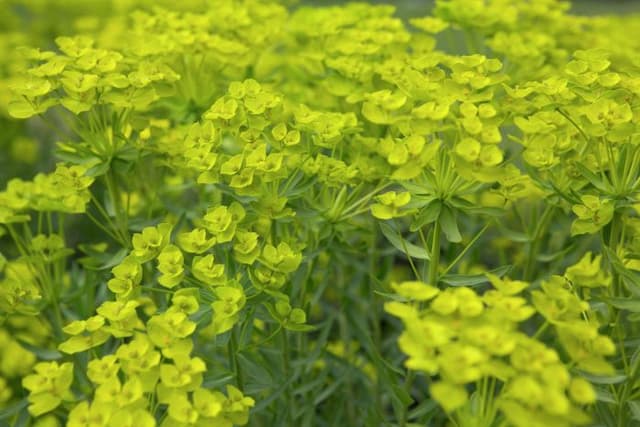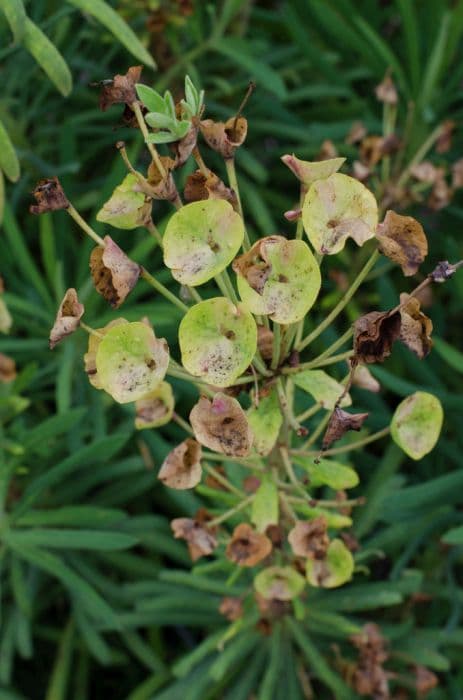Azorean Spurge Euphorbia stygiana

ABOUT
Euphorbia stygiana, commonly known as the Azorean spurge, is a striking plant with a bold appearance. The plant features a prominent rosette of dark green leaves that have a somewhat glossy look. These leaves often have a slightly crinkled texture, providing a unique visual interest. The foliage is arranged in a dense spiral pattern, emerging from a central point and creating an architectural feel. During its blooming period, the Azorean spurge produces flower structures that are known as cyathia. This is a specialized cluster that includes tiny flowers surrounded by bracts, which may be mistaken for petals. These structures are often yellow or red in color, creating a striking contrast against the dark foliage. The small, actual flowers within are typically inconspicuous. The overall appearance of Euphorbia stygiana is quite robust and substantial, giving it a lush and tropical aesthetic despite its temperate origins. The plant exudes a certain resilience and vigor, making it a visually impactful element in any garden composition where it may be featured.
About this plant
 Names
NamesFamily
Euphorbiaceae
Synonyms
Azorean Spurge, St. Michael's Spurge
Common names
Euphorbia mellifera subsp. stygiana, Euphorbia stygiana subsp. stygiana.
 Toxicity
ToxicityTo humans
Euphorbia stygiana, commonly known as Azores Spurge, contains a toxic milky latex in its tissues that can cause significant irritation upon contact with skin or mucous membranes. If ingested, the latex can induce symptoms such as burning pain in the mouth and throat, swelling of the lips and tongue, vomiting, and diarrhea. In severe cases, ingestion may lead to more serious symptoms like difficulty swallowing, breathing problems, and intense gastrointestinal distress. Contact with the eyes can result in temporary blindness and severe eye irritation. It is crucial to handle Azores Spurge with care and avoid ingestion of any part of the plant to prevent these toxic effects.
To pets
Azores Spurge is toxic to pets due to the presence of a milky latex that can be found throughout the plant. If your pet ingests any part of Azores Spurge, they may exhibit symptoms such as drooling, vomiting, diarrhea, and mouth irritation. In some cases, the latex can cause severe inflammation of the digestive tract, resulting in symptoms like abdominal pain and difficulty breathing. Contact with the eyes may lead to conjunctivitis or blindness. If you suspect your pet has ingested Azores Spurge, seek veterinary care immediately to treat these potential toxicities.
 Characteristics
CharacteristicsLife cycle
Perennials
Foliage type
Evergreen
Color of leaves
Green
Flower color
Yellow-Green
Height
6 feet (1.8 meters)
Spread
5 feet (1.5 meters)
Plant type
Shrub
Hardiness zones
9
Native area
Azores
Benefits
 General Benefits
General Benefits- Ornamental Value: Euphorbia stygiana, commonly known as Azorean spurge, adds aesthetic appeal to gardens with its attractive foliage and structure.
- Wildlife Habitat: Provides shelter and food for various insects, offering ecological support to garden ecosystems.
- Drought Tolerance: Once established, Azorean spurge is tolerant of drought, making it suitable for xeriscaping and low-water gardens.
- Erosion Control: The root system can help stabilize soil and prevent erosion on slopes and banks.
- Low Maintenance: Requires minimal care once established, needing less frequent watering and pruning compared to other garden plants.
- Habitat Restoration: Can be used in native plant gardens to help restore habitats, particularly within its indigenous range in the Azores.
 Medical Properties
Medical PropertiesThis plant is not used for medical purposes.
 Air-purifying Qualities
Air-purifying QualitiesThis plant is not specifically known for air purifying qualities.
 Other Uses
Other Uses- Euphorbia stygiana's sap has been traditionally used as a fish poison in some cultures, incapacitating fish to make them easier to collect.
- The milky sap of Euphorbia stygiana can be used as a temporary natural adhesive for small crafts or as a sealant in traditional practices.
- Its robust and compact growth habit makes Euphorbia stygiana suitable for use as a protective hedge in gardens or as a windbreak in coastal areas.
- The plant's unique texture and form are often utilized in landscape design to add an architectural element to rockeries and succulent gardens.
- Euphorbia stygiana can be cultivated to provide a natural habitat for beneficial insects, thereby promoting biodiversity.
- The wood of Euphorbia stygiana, although not commonly used, could be harvested and experimented with for creating small-scale sculptures or as part of mixed-media art projects.
- Due to its striking appearance, the Euphorbia stygiana can be used in dried flower arrangements to add a unique and lasting visual interest.
- In regions where Euphorbia stygiana grows abundantly, its branching pattern can inspire patterns or motifs in local textile and pattern design.
- The intricate structure of Euphorbia stygiana can be used as a natural model in educational settings to study plant form, growth, and resilience.
- Euphorbia stygiana may serve as a living laboratory for studying plant adaptation and evolution due to its survival in varying climatic conditions.
Interesting Facts
 Feng Shui
Feng ShuiThe Euphorbia stygiana, commonly known as Azorean spurge, is not used in Feng Shui practice.
 Zodiac Sign Compitability
Zodiac Sign CompitabilityThe Azorean spurge is not used in astrology practice.
 Plant Symbolism
Plant Symbolism- Resilience: Euphorbia stygiana, commonly known as the Azores Spurge, is a plant that thrives in tough environmental conditions, symbolizing the ability to withstand challenges and adversity.
- Adaptability: The Azores Spurge's capacity to adapt to various habitats represents the trait of adaptability in human nature.
- Protection: This plant has a sap that is toxic to many animals, which can symbolize the idea of setting boundaries and protecting oneself from harm.
- Healing: Historically, some euphorbias have been used in traditional medicine, signifying the plant's association with healing and medicinal properties.
 Water
WaterAzorean Spurge needs consistent moisture but does not like to be waterlogged. Water the plant when the top 1-2 inches of soil feel dry to the touch, which typically amounts to once a week, depending on the climate and season. Provide approximately 16 ounces of water for smaller pots, and up to 1 gallon for larger pots per watering session. Ensure the pot has good drainage to prevent water from pooling at the bottom, which could cause root rot. During winter months, reduce watering to every other week or less, as the plant will enter a dormant period and require less moisture.
 Light
LightAzorean Spurge thrives best in partial to full sunlight. It should be placed in a spot where it can receive at least four to six hours of direct sunlight daily, but protected during the hottest part of the day if necessary. An east or west-facing window would be an ideal spot indoors, while an area that gets morning sun and afternoon shade works well outdoors.
 Temperature
TemperatureAzorean Spurge prefers mild temperatures and can generally tolerate conditions between 50 to 70 degrees Fahrenheit. It is hardy to USDA zones 8 to 11 and can survive brief periods as low as 30 degrees Fahrenheit. If possible, the ideal temperature range for this plant is between 60 to 65 degrees Fahrenheit.
 Pruning
PruningPruning Azorean Spurge is essential for controlling its shape and encouraging a bushy growth habit. Prune in the late winter or early spring before the new growth starts. Cut back any leggy or overgrown stems and remove any dead or damaged material. Pruning is typically done once a year, but the plant can be lightly trimmed as needed throughout the growing season to maintain its form.
 Cleaning
CleaningAs needed
 Soil
SoilThe best soil mix for Azorean Spurge (Euphorbia stygiana) is well-draining, with a mix of loam, sand, and peat, as well as perlite to increase aeration. The ideal soil pH for Azorean Spurge should be slightly acidic to neutral, around pH 6.0 to 7.0.
 Repotting
RepottingAzorean Spurge (Euphorbia stygiana) should typically be repotted every two to three years or when it has outgrown its pot to ensure continued growth and root health.
 Humidity & Misting
Humidity & MistingAzorean Spurge (Euphorbia stygiana) thrives best in moderate humidity conditions, aiming for a humidity level of around 50%.
 Suitable locations
Suitable locationsIndoor
Provide bright indirect light, allow soil to dry slightly between watering.
Outdoor
Plant in partial shade, protect from strong winds, and mulch in winter.
Hardiness zone
9-11 USDA
 Life cycle
Life cycleEuphorbia stygiana, commonly known as the Azores Spurge, begins its life cycle as a seed which germinates in moist, well-drained soil, typically in spring or early summer. Upon sprouting, it enters a juvenile vegetative stage, forming a rosette of leaves at the ground level and developing a root system. As it matures into an adult, it grows upright stems and large leaves arranged in spirals, and during the flowering stage, it produces terminal inflorescences composed of small, inconspicuous flowers surrounded by showy, yellowish-green bracts that attract pollinators. Following pollination, the Azores Spurge develops fruit capsules that contain seeds, which, when mature, burst open to disperse seeds into the surrounding environment. The plant also exhibits perennial characteristics, with woody stems that persist over time, allowing it to grow larger and spread through both seed production and vegetative propagation. Significant to its survival, the Euphorbia stygiana has adapted to its native habitat in the Azores, tolerating occasional droughts, which contributes to its life cycle resilience.
 Propogation
PropogationPropogation time
Spring-Early Summer
Euphorbia stygiana, commonly known as Azores Spurge, can be propagated by seed or division, but the most popular method is by seed. To propagate Azores Spurge by seed, it is best done in the spring when temperatures are milder. Seeds should be sown in a well-draining seed starting mix, covered lightly with soil and kept at around 70°F (approximately 21°C). They require consistent moisture and should be kept in a bright area but out of direct sunlight to prevent scorching. Germination can take several weeks, and once seedlings are large enough to handle, they can be transplanted into individual pots. Seedlings should be grown on in cooler conditions before acclimatizing and planting out into their permanent position in late spring or early summer.









